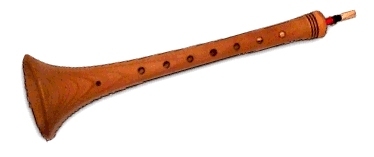Mid-Eastern Musical Instruments
![]()
Strings
Oud


The ancient and modern lute![]() of the Middle
East, is known from the 7th century. It traveled
to Europe in
such a roundabout way that in 1555 Bermudo could call the lute a "vihuela
de Flandres". The modern oud has a shorter neck than the European
lute. Its pegbox is thrown back at a less acute angle, and it usually has
3 soundholes and no frets. Today the oud is very popular all the way from
Morocco to Istanbul.
of the Middle
East, is known from the 7th century. It traveled
to Europe in
such a roundabout way that in 1555 Bermudo could call the lute a "vihuela
de Flandres". The modern oud has a shorter neck than the European
lute. Its pegbox is thrown back at a less acute angle, and it usually has
3 soundholes and no frets. Today the oud is very popular all the way from
Morocco to Istanbul.
![]()
Saz
![]()
Turkish Long
Neck Lute![]() .
It originated in Central Asia
where Turks lived before their westward migration. The Saz, also called
'baglama', is the most popular stringed instrument in Turkey. It is the
grandfather of the Greek
.
It originated in Central Asia
where Turks lived before their westward migration. The Saz, also called
'baglama', is the most popular stringed instrument in Turkey. It is the
grandfather of the Greek![]() Bouzouki
Bouzouki![]() ,
and although similar in shape to the Bouzouki, the construction, size and
sound of the Saz is different.
,
and although similar in shape to the Bouzouki, the construction, size and
sound of the Saz is different.
![]()
Bouzouki

The bouzouki![]() ,
although a distinctly Greek
,
although a distinctly Greek![]() instrument, is a relatively modern offshoot
of the Turkish saz
instrument, is a relatively modern offshoot
of the Turkish saz![]() .
The early bouzoukis at the turn of the century looked like sazes, with
one piece bodies, no soundhole on the face, wooden tuning pegs, but with
metal chromatic frets. By the early 1920's, the influence of Italian
.
The early bouzoukis at the turn of the century looked like sazes, with
one piece bodies, no soundhole on the face, wooden tuning pegs, but with
metal chromatic frets. By the early 1920's, the influence of Italian![]() mandolin making had altered the bouzouki into
the basic form it is today, with a staved bowl back, machine gear tuners,
oval or round soundhole. The name is a derivative of the Turkish word "bozuk"
which referred to a particular size of baglama/saz and to a standard tuning
pattern still used in saz playing. The first great use of the bouzouki
was in the rebetiko
mandolin making had altered the bouzouki into
the basic form it is today, with a staved bowl back, machine gear tuners,
oval or round soundhole. The name is a derivative of the Turkish word "bozuk"
which referred to a particular size of baglama/saz and to a standard tuning
pattern still used in saz playing. The first great use of the bouzouki
was in the rebetiko![]() music between WWI and WWII. The rebetiko scene,
with its underworld glamour and waterfront nightclubs, favored the sound
of bouzoukis and the smaller baglama, a "miniature" bouzouki,
with guitar
music between WWI and WWII. The rebetiko scene,
with its underworld glamour and waterfront nightclubs, favored the sound
of bouzoukis and the smaller baglama, a "miniature" bouzouki,
with guitar![]() accompaniment.
accompaniment.
![]()
Kemence
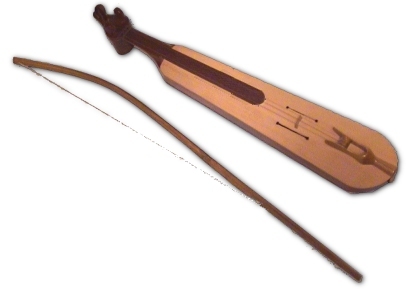
Turkish-Armenian
fiddle with 3 strings. The kemence is held by the neck with the left hand
and bowed like a cello![]() with the right. Traditionally used as a solo
instrument for both singing and dancing, as well as listening.
with the right. Traditionally used as a solo
instrument for both singing and dancing, as well as listening.
![]()
Cumbus

Zeynel Abidin Cumbus
(pronounced "joom-bush") invented the instrument which bears
his name in the early 20th century. The cumbus proved to be so popular
that it all but drove the oud![]() from the field. Its body consists of a skin stretched over the mouth of
a metal bowl. The neck is much longer than the oud's and fretless. The
body was borrowed from the much older "Yayli Tambur" (bowed tambur).
from the field. Its body consists of a skin stretched over the mouth of
a metal bowl. The neck is much longer than the oud's and fretless. The
body was borrowed from the much older "Yayli Tambur" (bowed tambur).
![]()
Santoor
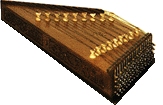
The santoor![]() is a 3-octave Middle Eastern
hammered dulcimer
is a 3-octave Middle Eastern
hammered dulcimer![]() tuned in octaves across the bridge rather than fifths like the American
hammered dulcimer.
tuned in octaves across the bridge rather than fifths like the American
hammered dulcimer.
![]()
Turkish Fiddle

A fiddle with a round handle that pierces
the body and projects at the lower end, forming a cello-like![]() spike. The earliest fiddles seem to have been spike fiddles. Al
Farabi mentions spikes in the 10th C. Traditionally
of Kurdistan origin,
spike fiddles are found in Egypt and
Asia today. It
has four metal strings with a gourd body and skin head.
spike. The earliest fiddles seem to have been spike fiddles. Al
Farabi mentions spikes in the 10th C. Traditionally
of Kurdistan origin,
spike fiddles are found in Egypt and
Asia today. It
has four metal strings with a gourd body and skin head.
![]()
Rebab, Rebaba, Rababa
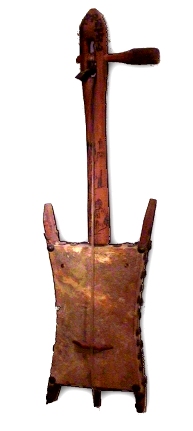
Stringed instrument with one or two
strings and played with a bow. Only used in music of the Middle
East. The rebab is very popular in Bedouin
chanting but can be found in all of the Arabic folk
music![]() .
Ancestor of the western Violin
.
Ancestor of the western Violin![]() and other European
bowed stringed instruments.
and other European
bowed stringed instruments.
![]()
Qanun

A plucked Arabic![]() instrument whose 30 strings may be varied
in pitch by the use of small bridges. Its sounding box is half-covered
in wood, half in a heavy skin like a drum. It has seventy-two strings all
of gut, and is held flat on the knees for playing. It's origins are in
Armenia.
instrument whose 30 strings may be varied
in pitch by the use of small bridges. Its sounding box is half-covered
in wood, half in a heavy skin like a drum. It has seventy-two strings all
of gut, and is held flat on the knees for playing. It's origins are in
Armenia.

Tar

The tar is the long-necked lute![]() of the Caucasian,
played in Azerbaijan,
Tadzhikistan,
Iran and Armenia.
The body is hollowed out of a single piece of wood into a rounded figure-8
shape, with a skin belly, friction tuning pegs and moveable frets. The
tar has metal strings, and is played with a plectrum.
of the Caucasian,
played in Azerbaijan,
Tadzhikistan,
Iran and Armenia.
The body is hollowed out of a single piece of wood into a rounded figure-8
shape, with a skin belly, friction tuning pegs and moveable frets. The
tar has metal strings, and is played with a plectrum.
![]()
Percussion
Dumbek - Darabukka
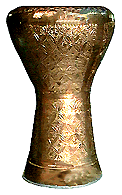
A goblet-shaped Middle-Eastern
drum which is made from earthenware or terra-cotta pottery, wood or metal.
The single drum head, made from stretched parchment, bayard-fish, goat-skin
or other leather, is attached directly to the frame by nails and glue or
laced onto the head and body. The bottom of the drum is left open. Held
under a player's arm.
![]()
Tambourine
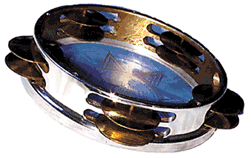
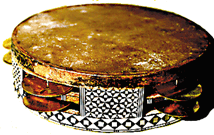
Tambourine is a hand-held instruments
with a round wooden frame and parchment or skin heads. Though an ancient
instrument, its structure has remained virtually unchanged. When you strike
the drum-head, jingles made from shell, metal or other small objects on
the edge, create a beautiful, shimmering sound.
![]()
Tar (Def)
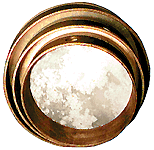
Middle Eastern
frame drum. The Tar is like a large tambourine![]() .
It is a main instrument in Arabic music
.
It is a main instrument in Arabic music![]() and dancing accompaniment. With a goat skin head and a laminated hardwood
shell.
and dancing accompaniment. With a goat skin head and a laminated hardwood
shell.
![]()
Hand Drum
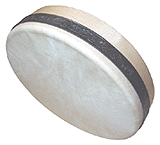
Fun hand drums from the Middle
East with beautiful inlaid wooden body.
![]()
Winds
Ney

Long end-blown cane flute![]() of the Near-East,
used from Egypt to
Persia. The sound
is produced by blowing across the sharp edge with pursed lips.
of the Near-East,
used from Egypt to
Persia. The sound
is produced by blowing across the sharp edge with pursed lips.
![]()
Zurna
The zurna is a loud and
wonderful primitive kind of oboe![]() from the Middle
East. A double reed instrument with a long,
conical wooden body and a flaring bell.
from the Middle
East. A double reed instrument with a long,
conical wooden body and a flaring bell.
![]()
Duduk

The Duduk or Mey is identical in Turkey
and Armenia.
Thumbhole, 7 fingerholes, a gigantic double reed, but an astonishingly
mellow tone. Sounds like an ethereal clarinet![]() .
.
![]()
Low G Clarinets

The traditional low G clarinets has
one of the characteristic sounds in Turkish
music. It is made of metal.
![]()
Images and sounds courtesy of
